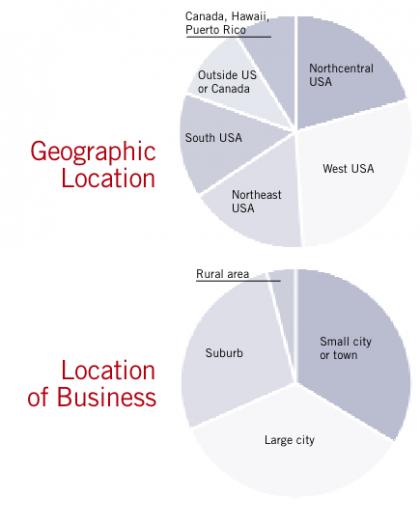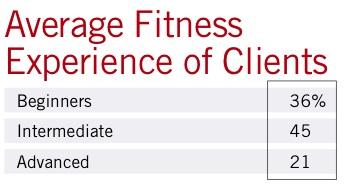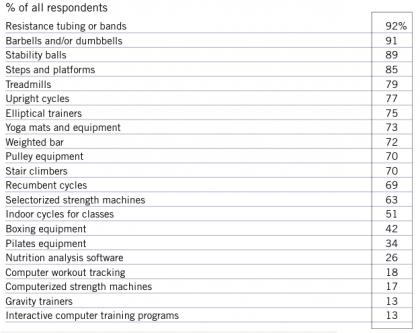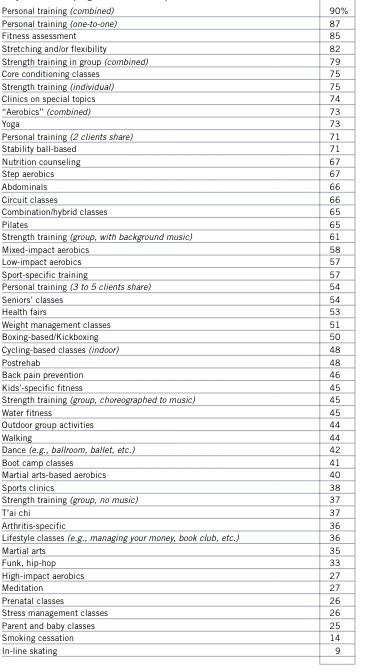8th Annual 2003 IDEA Fitness Programs & Equipment Survey

Survey Respondents
The demographics of the businesses where the respondents work.
- According to industry definitions, “multipurpose” health clubs have a fitness facility and racquet courts. “Fitness-only” health clubs have fitness (group exercise and/or fitness center with equipment), but no racquet courts. Either type of club may have a swimming pool or gymnasium.
- Respondents were 36% owners, 10% general managers, 17% fitness directors, 11% program directors, 4% personal training directors and 11% group fitness directors/coordinators. The rest had a variety of titles.
Customer Profile
- Percentages in this section are likely the respondents’ estimates or observations. Respondents may not have had reference data.
- The estimated percentages do not equal 100% because of rounding.
- 43% have a swimming pool available for fitness classes.
- 64% sell products or have a pro shop.
- 87% offer classes and programs to attract the inactive or new exerciser.
- 72% of clients stay with the business 1 year or longer.
How to Read the Numbers
The percentage (%) reflects the number of survey respondents who answered yes to a given survey question. All percentages have been rounded up at .5 and down at .4. Except for demographic information, percentages do not necessarily total 100, because of multiple responses.
The mean, or average, is all of the answers added together and then divided by the number of respondents. An average can be influenced by extremely high and extremely low numbers. In some cases, the extremely high and extremely low responses were eliminated to present a more accurate number.
The median is the midpoint, where half of the respondents answered above and half answered below. A median is useful because, unlike an average, it is not influenced by high and low extremes.
In June and July 2003, three
e-mails were sent to IDEA business and program director members who gave IDEA permission to contact them. Respondents linked to a Web-based survey; 276 completed questionnaires for a 17% response rate.
At a 95% confidence level, the margin of error is +/– 5.4%.
Equipment
- Large stationary equipment is frequently and consistently offered.
- After a rapid rise, elliptical trainers are plateauing, having achieved usage in 75% of facilities.
- The smaller, portable pieces of equipment continue to climb in use. Stability balls, weighted bars and yoga mats have become peers to the pervasive free weights, resistance tubing and steps.
- Equipment and programs are increasingly intertwined. The prevalence of indoor cycles and stability balls are comparable to the programs that utilize them. Weighted bars and resistance bands/tubing
are typically used in group strength classes. Both large stationery pieces and small, portable items can be found in formats such as circuits
or sports conditioning.
- Computer software has entered the fitness scene, but is still finding a niche. It is too early to tell how this category will prevail over the next few years.
Programs and Activities
- Programs that are growing, such as yoga, Pilates and postrehab, are highly dependent on the skill of the staff. These offerings may be impacted over the years by a manager’s ability to find well-qualified staff.
- Programs for specific populations such as seniors, kids or postrehab, tend to be highly related to local populations and business niches.
For example, a kids’ program may thrive in a YMCA or JCC while a corporation or personal training gym does not even offer a kids’ program.
- Equipment use continues to dominate the popular activities and be
the base of rising stars. Considering that successful training can occur without equipment, the level of equipment use may be a reflection of a desire to continually offer clients options that maintain interest.
- The term “combined” means that subcategories have been added together. “Personal training (combined)” adds together one-to-one,
2 clients share and small-group. “Strength training in group (combined)” includes no music, background music and choreographed
to music. “Aerobics (combined)” adds together high-, low- and mixed-impact.
Financing Fitness
- The majority of respondents work
in multiple purpose or fitness-only health clubs or YMCA/YWCA/JCC sites, which traditionally use a dues model. It is interesting to see that monthly dues are a strong option.
- Respondents writing in “payroll
deduction” noted the corporate or
hospital wellness location.
- Fitness services included in tuitions or other fees was reported by university programs (“student fees”) and by a country club.
- Who gets services for free? Write-in comments included in this category are from a military base and a kids’ gymnastics center that offers parents free fitness. Other respondents did not explain.
- Customer retention is likely to increase when new clients/members understand how to use the gym
or equipment, what to realistically expect and how to measure success. Fitness assessments and personal training can give those new to
fitness a strong start to stay with
a program.
- 72% of respondents retain clients/
members for one year or longer, which indicates all these diverse
payment models are working.
- 85% of YMCA/YWCA/JCC, 61% of multipurpose plus fitness-only health clubs and 43% of corporate fitness plus hospital wellness centers report charging annual membership dues plus separate fees for some classes or programs.
- 97% of personal training, 68% of group exercise studio plus satellite classes, 63% “other” and 43% multipurpose plus
fitness-only health clubs charge for individual session/class or package of sessions or classes. - Interesting to note that owners are charging extra for group strength training, no music (perhaps small classes in the weight room?), but not for group strength choreographed to music, which is often identified as a branded program. Group strength training to background music is probably occurring in the group exercise room.
Which of the following equipment is provided to your clients?
We appreciate the time you took to complete the survey, which helps all IDEAÔÇêmembers. A special thanks to those who completed the Web-based survey and informed us of your challenges so we could fix them.
Sandy Todd Webster
For 22 years, Sandy Todd Webster was the chief architect of IDEA's content program - including the award-winning IDEA FITNESS JOURNAL and IDEA FOOD & NUTRITION TIPS - the industry's leading resources for fitness, wellness and nutrition professionals worldwide. She created, launched and nurtured these brands and many others during her productive and purposeful IDEA tenure. Sandy is a Rouxbe-certified professional plant-based cook and a Precision Nutrition Level 1 Coach who is pursuing a Master's degree in Sustainable Food Systems through The Culinary Institute of America (expected August 2024). She plans to combine these passions with her content expertise to continue inspiring others to make the world a more just, healthy and regenerative place.

















